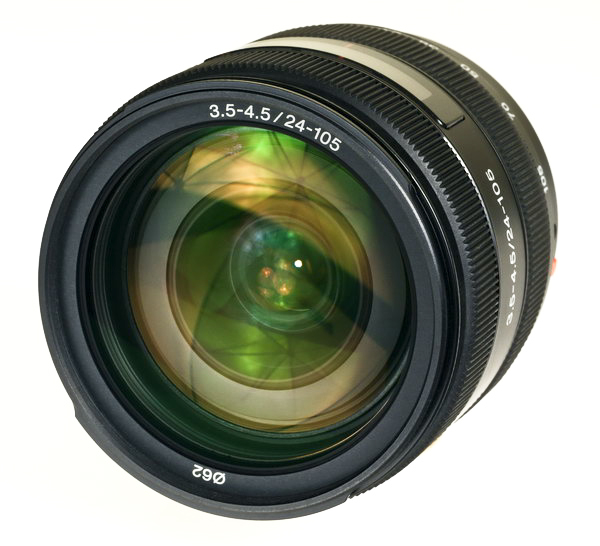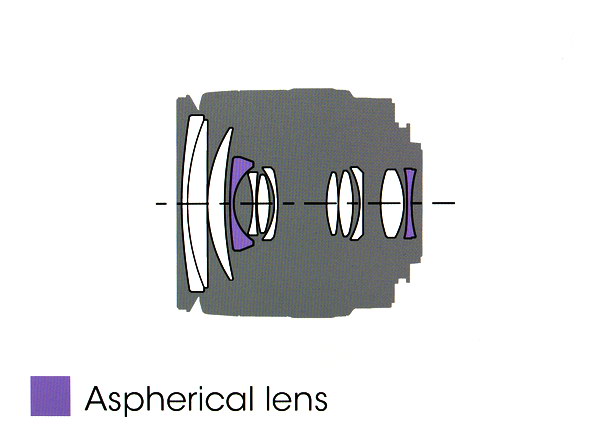|
Here’s a brief look at the Sony 24-105mm F/3.5-4.5 zoom lens. Scroll down for the review.
Requisite product shots.
The Sony A700 and A900 were used for this review. For full frame results, go to the bottom of the page. For a better understanding of my review methods and terminology, go here.
The Sony 24-105mm F/3.5-4.5 (made in Japan) is about the smallest zoom Sony has for sale at this time. It’s a little smaller, but heavier than the “kit” 18-70mm lens. This lens can be used on a full frame or film camera, as well as APS-C cameras, and is a re-badged Minolta from 2000. The finish is Sony matte black, and made of a mixture of metal and plastic, with a moderately good build quality, except for the zoom ring, see zooming below. It has the focus distance window marked with feet and meters. It has a metal mount. One thing I don’t like about the new Sony lenses is the ribbed rubber zoom and focus ring grips, they catch dirt very easily and it’s hard to clean off. The focal length scale is marked at 24mm, 35mm, 50mm, 70mm and 105mm. The EXIF data matches those marks. The lens is multi-coated and has the green/amber look. Sony claims the lens has two glass molded asperical elements inside. Zooming. The barrel extends out 1.5″ (39mm) when zooming, unfortunately, the zoom motion is very sticky. It requires too much effort to turn. There’s no zoom lock, but you shouldn’t need one. Focusing seems accurate and pretty quick. The ring doesn’t turn in auto-focus mode, but if you turn the ring hard, it will give, because it has a clutch device built-in. Manual focusing takes some effort as the ring is slightly stiff, but that may loosen up with use. From close focus to infinity takes about 1/6 of a turn, that’s pretty quick. There is no back-slop when manually focusing.
Lens flare/ghosting is typical for a wide zoom, look for heavy veiling flare and ghosting at wide angle, see sample images below.
Filter size is 62mm, which is the same as the Sony 18-200mm, 18-250mm, Carl Zeiss 16-80mm lens, 16-105mm and the 70-300mm G lens.
Filter use. There is slight additional vignetting using a regular filter on a full frame camera, but none on APS-C.
Color looks the same as other Sony lenses.
Coma. Fairly Strong from 24-30mm and F/3.5, clears up by F/4.5-5.
Color fringing. Control here is average to below average. Look for a lot of purple/blue towards the long end of the zoom, especially when taking pictures of white roof tops and dark A/C units. It isn’t too noticeable in regular photos. At wide angle, the control is better. Check out the 105mm corner crops below. Color fringing also shows up in the center of the image, but stopping down helps get rid of it.
Bokeh. Not too bad across the zoom, the crops below show the best-case results. I’d say neutral over the entire frame and for short to moderate focusing distances.
Aperture/focal length guide for the Sony 24-105mm F/3.5-4.5 zoom
The numbers above show you can wind up with F/4 or F/4.5 at 50mm, this happens on many zooms.
Lens distortion below.
Distortion. Moderate to strong barrel distortion at 24mm, by 40mm it’s flat, then pincushion starting at 50mm, and becoming moderate by 105mm. Random shots below.
The two top shots illustrate flare and ghosting from the 24-105mm lens at 24mm. There is heavy veiling glare with the sun just out of the image, solve this issue by using your hand to block the incoming light. The right shot shows some ghosts, like the semi-circular orange blob at lower center, and other smaller ones to the left of that, which don’t show up very well in this small image. Towards the telephoto end, you’ll see a golden arrow opposite the sun, but this only happens when the sun is very close or in the picture. When the sun is centered in the frame, there’s a very noticeable ring around the sun at all focal lengths.
The included petal type hood ($25 to replace) doesn’t do any good at wide angle to control ghosting or veiling glare with the sun just outside the image, use your hand as I said above. With the sun inside the frame, obviously a hood or hand will do no good either. This lens is about average for controlling flare and ghosting, and is similar to most other Sony lenses with this zoom range.
Middle crops show bokeh. Pretty smooth in normal situations, though sometimes it looks a little busy depending on the size and distance of the points of light from the subject.
Bottom crops show coma. The 24mm F/3.5 crops show some rather heavy coma, but one stop down and it’s gone. Odd, but the full frame crops look better, see at the bottom of the page.
Light fall-off below.
Light fall-off is fairly mild, but stopping down really doesn’t so much. As you move on to the long end, it disappears. There is virtually no light-fall at 105mm on an APS-C camera, so no boring pictures. Check out the full frame results at the bottom of the page, which are far different than what you see above.
Actual light fall-off or corner shading results below with real subject. 24mm @ F/3.5
 As you can see, it doesn’t show up in real pictures.
Next we’ll check out the center sharpness.
The 24mm centers are a little soft at F/3.5, this is caused by spherical aberration, and affects the whole picture, but it’s not bad, there’s still good detail present. By F/4.5-5, it’s nice and sharp. I used F/5.6 in the sample above just for the sake of uniformity. Moving on to 105mm, good performance here, the centers are sharp at F/4.5-8, that’s good news.
Corner sharpness next.
The corners at wide angle are quite sharp, but veiling haze is present just like the centers. A stop down and it’s gone. 105mm corners next.
The 105mm corners are soft at F/4.5 and F/5.6. You’ll get a big sharpness gain by stopping down to F/8, F/11 goes soft again. On a side note; all images above are 100% crops of the original image. It’s hard to pick this stuff out at normal viewing sizes.
Close focus image next.
Below, check out the maximum magnification sample. This shot is a 100% cropped portion of the full size picture. The sample shot was taken with the Sony A 700 12.2MP camera. The subject is a standard US stamp, 1″x 3/4″ or 25.4mm x 19mm. Also, note the macro shot was taken as close to the subject as focusing allowed; In this case a long 16.5″ (419mm), measured from the front of the lens barrel to the subject.
|
This lens produced a nice close focus shot, at a distance of 16.5″ (419mm) although is doesn’t have a very high reproduction ratio (.18x), it is sharp however, and F/5.6-8 produced the best images with our test stamp.
|
Full frame results using the Sony A900 below. Check out the differences when using a film or full frame camera below. I’m only pointing out the noticeable issues as compared to the APS-C bodies, so if I don’t show it here, the results are not significantly different enough to warrant posting an additional set of images in this section. Light fall-off
Light fall-off is heavy at 24mm, F/3.5, and noticeable in real shots, see image below. Stopping down gets rid of most, but not all dark corners. Also, when using a regular filter, (not thin) the corners are slightly darker wide open at 24mm. At 105mm, there’s mild corner darkening, but very manageable, and not noticeable in real shots. Full image from A900 below.  Here’s a real shot using F/3.5 at 24mm. Corner darkening is fairly harsh, and obviously noticeable when presented as I’ve done here. I actually like this look, and ad it to my images now with lenses that don’t vignette like this. If you use a normal aperture for this landscape shot, like F/5.6-8, you wouldn’t notice this. Save F/3.5 for low-light conditions. 24mm corner samples next.
The corners hold up very nicely with a full frame camera. In fact, they don’t look much different than the Sony 24-70mm F/2.8 Carl Zeiss results. 105mm corners below.
The 105mm corners don’t sharpen up until F/8-11. There isn’t much difference between the images above, and the APS-C shots. Obviously, the corners aren’t as sharp as the centers, but for full frame, extreme corner shots, they still look good. Again, they look comparable to the much more expensive Sony 24-70mm F/2.8 CZ lens. You can also see the lateral color fringing in the crops, this type of color fringing doesn’t go away as you stop down. Distortion next.
There is moderate to heavy distortion at both ends on the A900. The barrel distortion pattern is complex, showing a rise in the middle, then falling off hard towards the sides, and leaving the ends flat. This requires extra effort to correct in post-processing. Pincushion is a gradual curve, and is easy to fix. Coma results with full frame.
This is coma @ 24mm on the A900. It’s controlled well, and ironically, looks better than the APS-C crops. Also, coma is reduced as you get closer to the extreme corners–odd! These crops were taken more towards the central corners instead of the usual extreme corners, I’m showing the worst of it. As always, don’t try to compare crops between lens reviews and cameras as I have taken them on a different day, from a different angle and a different distance. The 100% crops in this A900 section are generally from the extreme corners. Printing out the whole image as you might see it on your screen would measure 65″ (1.65m) wide! |
Full Size Images
In the gallery are 12 full size images for you to check out, each 6048×4032. These were taken with the full frame Sony A900, in Jpeg format, so no RAW files or conversions here. Most of the images are pretty sharp, even using a wide aperture, however, it looks like F/11 results in maximum resolution for landscape type shots. I do see some soft edges on the right side of my particular sample, (mostly noticeable with a wide aperture), I’m not sure if there are variations in sample quality or not, I only had one that I purchased on eBay.
Click yellow tabs Below to download the full size images.
Harbor Rock Island Palms Boats Bay Club Sea wall Rock climbing Harbor overlook City view Sea Gull Friendship White Building Lighthouse
For APS-C users; good things first: It has little in the way of dark corners, it’s pretty sharp in the centers from F/4-8, wide angle or telephoto, and the corners aren’t too bad if stopped down to F/5.6-8. You’ll get some good old fashioned purple fringing on the telephoto end, unfortunately, stopping down doesn’t help here; but newer camera bodies may fix this automatically in camera. This is a relatively fast lens, and has a 35mm equivalent zoom range of 36-157mm. It’s a good daily walk around lens if you don’t want or need to go ‘really’ wide angle.





































































